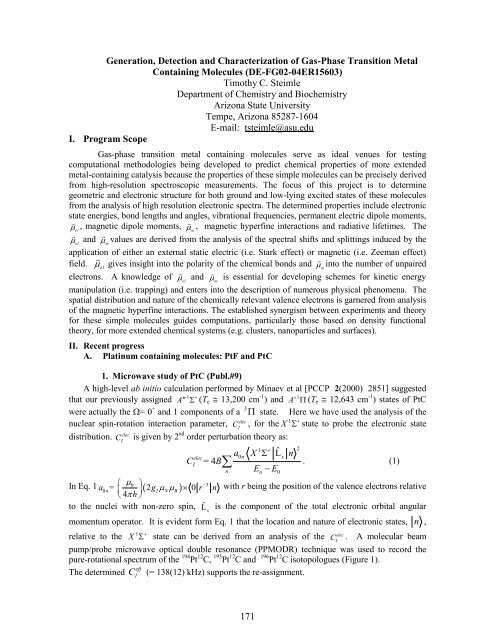Eighth Condensed Phase and Interfacial Molecular Science (CPIMS)
Eighth Condensed Phase and Interfacial Molecular Science (CPIMS)
Eighth Condensed Phase and Interfacial Molecular Science (CPIMS)
You also want an ePaper? Increase the reach of your titles
YUMPU automatically turns print PDFs into web optimized ePapers that Google loves.
Generation, Detection <strong>and</strong> Characterization of Gas-<strong>Phase</strong> Transition Metal<br />
Containing Molecules (DE-FG02-04ER15603)<br />
Timothy C. Steimle<br />
Department of Chemistry <strong>and</strong> Biochemistry<br />
Arizona State University<br />
Tempe, Arizona 85287-1604<br />
E-mail: tsteimle@asu.edu<br />
I. Program Scope<br />
Gas-phase transition metal containing molecules serve as ideal venues for testing<br />
computational methodologies being developed to predict chemical properties of more extended<br />
metal-containing catalysis because the properties of these simple molecules can be precisely derived<br />
from high-resolution spectroscopic measurements. The focus of this project is to determine<br />
geometric <strong>and</strong> electronic structure for both ground <strong>and</strong> low-lying excited states of these molecules<br />
from the analysis of high resolution electronic spectra. The determined properties include electronic<br />
state energies, bond lengths <strong>and</strong> angles, vibrational frequencies, permanent electric dipole moments,<br />
�el � , magnetic dipole moments, �m � , magnetic hyperfine interactions <strong>and</strong> radiative lifetimes. The<br />
�el � <strong>and</strong> �m � values are derived from the analysis of the spectral shifts <strong>and</strong> splittings induced by the<br />
application of either an external static electric (i.e. Stark effect) or magnetic (i.e. Zeeman effect)<br />
field. �el � gives insight into the polarity of the chemical bonds <strong>and</strong> �m � into the number of unpaired<br />
electrons. A knowledge of �el � <strong>and</strong> �m � is essential for developing schemes for kinetic energy<br />
manipulation (i.e. trapping) <strong>and</strong> enters into the description of numerous physical phenomena. The<br />
spatial distribution <strong>and</strong> nature of the chemically relevant valence electrons is garnered from analysis<br />
of the magnetic hyperfine interactions. The established synergism between experiments <strong>and</strong> theory<br />
for these simple molecules guides computations, particularly those based on density functional<br />
theory, for more extended chemical systems (e.g. clusters, nanoparticles <strong>and</strong> surfaces).<br />
II. Recent progress<br />
A. Platinum containing molecules: PtF <strong>and</strong> PtC<br />
1. Microwave study of PtC (Publ.#9)<br />
A high-level ab initio calculation performed by Minaev et al [PCCP 2(2000) 2851] suggested<br />
1 �<br />
that our previously assigned A"<br />
� (Te � 13,200 cm -1 1 ) <strong>and</strong> A' � (Te � 12,643 cm -1 ) states of PtC<br />
were actually the �= 0 + <strong>and</strong> 1 components of a 3 � state. Here we have used the analysis of the<br />
elec<br />
1<br />
nuclear spin-rotation interaction parameter, C , for the X I<br />
�<br />
� state to probe the electronic state<br />
elec<br />
distribution. C is given by 2 I<br />
nd order perturbation theory as:<br />
1 � 2<br />
a ˆL<br />
0n<br />
X �<br />
elec<br />
x n<br />
CI= 4B�<br />
. (1)<br />
E � E<br />
n n<br />
In Eq. 1<br />
� �0<br />
�<br />
�3<br />
a0 n = � �2g I �N�B��0 r n<br />
4�<br />
h<br />
�<br />
with r being the position of the valence electrons relative<br />
� �<br />
to the nuclei with non-zero spin, Lˆ is the component of the total electronic orbital angular<br />
x<br />
momentum operator. It is evident form Eq. 1 that the location <strong>and</strong> nature of electronic states, n ,<br />
1<br />
relative to the X �<br />
elec<br />
� state can be derived from an analysis of the C . A molecular beam<br />
I<br />
pump/probe microwave optical double resonance (PPMODR) technique was used to record the<br />
pure-rotational spectrum of the 194 Pt 12 C, 195 Pt 12 C <strong>and</strong> 196 Pt 12 C isotopologues (Figure 1).<br />
The determined C (= 138(12) kHz) supports the re-assignment.<br />
eff<br />
I<br />
171<br />
0
















